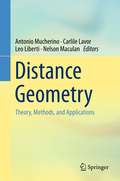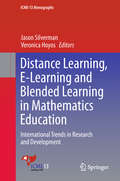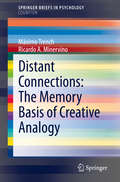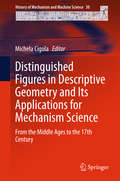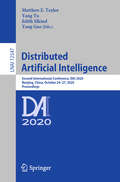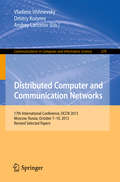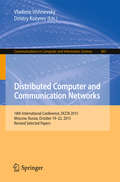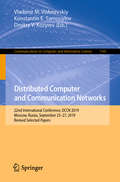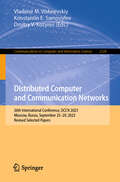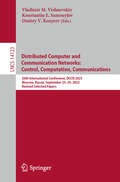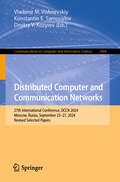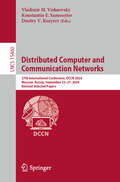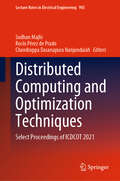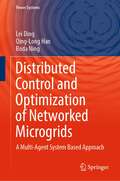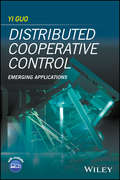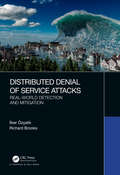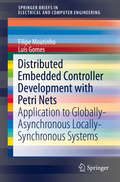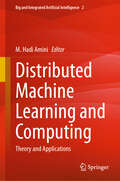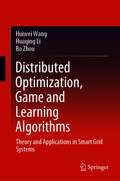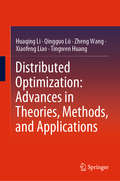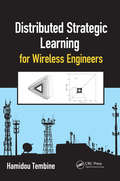- Table View
- List View
Distance Geometry
by Carlile Lavor Antonio Mucherino Leo Liberti Nelson MaculanThis volume is a collection of research surveys on the Distance Geometry Problem (DGP) and its applications. It will be divided into three parts: Theory, Methods and Applications. Each part will contain at least one survey and several research papers. The first part, Theory, will deal with theoretical aspects of the DGP, including a new class of problems and the study of its complexities as well as the relation between DGP and other related topics, such as: distance matrix theory, Euclidean distance matrix completion problem, multispherical structure of distance matrices, distance geometry and geometric algebra, algebraic distance geometry theory, visualization of K-dimensional structures in the plane, graph rigidity, and theory of discretizable DGP: symmetry and complexity. The second part, Methods, will discuss mathematical and computational properties of methods developed to the problems considered in the first chapter including continuous methods (based on Gaussian and hyperbolic smoothing, difference of convex functions, semidefinite programming, branch-and-bound), discrete methods (based on branch-and-prune, geometric build-up, graph rigidity), and also heuristics methods (based on simulated annealing, genetic algorithms, tabu search, variable neighborhood search). Applications will comprise the third part and will consider applications of DGP to NMR structure calculation, rational drug design, molecular dynamics simulations, graph drawing and sensor network localization. This volume will be the first edited book on distance geometry and applications. The editors are in correspondence with the major contributors to the field of distance geometry, including important research centers in molecular biology such as Institut Pasteur in Paris.
Distance Learning, E-Learning and Blended Learning in Mathematics Education: International Trends in Research and Development (ICME-13 Monographs)
by Jason Silverman Veronica HoyosThis book builds on current and emerging research in distance learning, e-learning and blended learning. Specifically, it tests the boundaries of what is known by examining and discussing recent research and development in teaching and learning based on these modalities, with a focus on lifelong mathematics learning and teaching. The book is organized in four sections: The first section focuses on the incorporation of new technologies into mathematics classrooms through the construction or use of digital teaching and learning platforms. The second section presents a wide range of perspectives on the study and implementation of different tutoring systems and/or computer assisted math instruction. The third section presents four new innovations in mathematics learning and/or mathematics teacher education that involve the development of novel interfaces’ for communicating mathematical ideas and analyzing student thinking and student work. Finally, the fourth section presents the latest work on the construction and implementation of new MOOCs and rich media platforms developed to carry out specialized mathematics teacher education.
Distance Sampling: Methods and Applications
by S. T. Buckland E. A. Rexstad T. A. Marques C. S. OedekovenIn this book, the authors cover the basic methods and advances within distance sampling that are most valuable to practitioners and in ecology more broadly. This is the fourth book dedicated to distance sampling. In the decade since the last book published, there have been a number of new developments. The intervening years have also shown which advances are of most use. This self-contained book covers topics from the previous publications, while also including recent developments in method, software and application. Distance sampling refers to a suite of methods, including line and point transect sampling, in which animal density or abundance is estimated from a sample of distances to detected individuals. The book illustrates these methods through case studies; data sets and computer code are supplied to readers through the book's accompanying website. Some of the case studies use the software Distance, while others use R code. The book is in three parts. The first part addresses basic methods, the design of surveys, distance sampling experiments, field methods and data issues. The second part develops a range of modelling approaches for distance sampling data. The third part describes variations in the basic method; discusses special issues that arise when sampling different taxa (songbirds, seabirds, cetaceans, primates, ungulates, butterflies, and plants); considers advances to deal with failures of the key assumptions; and provides a check-list for those conducting surveys.
Distant Connections: The Memory Basis of Creative Analogy (SpringerBriefs in Psychology)
by Máximo Trench Ricardo A. MinervinoAnalogical thinking lies at the core of human cognition, pervading from the most mundane to the most extraordinary forms of creativity. By connecting poorly understood phenomena to learned situations whose structure is well articulated, it allows reasoners to expand the boundaries of their knowledge. The first part of the book begins by fleshing out the debate around whether our cognitive system is well-suited for creative analogizing, and ends by reviewing a series of studies that were designed to decide between the experimental and the naturalistic accounts. The studies confirm the psychological reality of the surface bias revealed by most experimental studies, thus claiming for realistic solutions to the problem of inert knowledge. The second part of the book delves into cognitive interventions, while maintaining an emphasis on the interplay between psychological modeling and instructional applications. It begins by reviewing the first generation of instructional interventions aimed at improving the later retrievability of educational contents by highlighting their abstract structure. Subsequent chapters discuss the most realistic avenues for devising easily-executable and widely-applicable ways of enhancing access to stored knowledge that would otherwise remain inert. The authors review results from studies from both others and their own lab that speak of the promise of these approaches.
Distinguished Figures in Descriptive Geometry and Its Applications for Mechanism Science
by Michela CigolaThis book consists of chapters that focus specifically on single figures that worked on Descriptive Geometry and also in Mechanisms Sciences and contain biographical notes, a survey of their work and their achievements, together with a modern interpretation of their legacy. Since Vitruvius in ancient times, and with Brunelleschi in the Renaissance, the two disciplines began to share a common direction which, over the centuries, took shape through less well-known figures until the more recent times in which Gaspard Monge worked. Over the years, a gap has been created between Descriptive Geometry and Mechanism Science, which now appear to belong to different worlds. In reality, however, there is a very close relationship between the two disciplines, with a link based on extremely solid foundations. Without the theoretical foundations of Geometry it would not be possible to draw and design mechanical parts such as gears, while in Kinematics it would be less easy to design and predict the reciprocal movements of parts in a complex mechanical assembly.
Distributed Artificial Intelligence: Second International Conference, DAI 2020, Nanjing, China, October 24–27, 2020, Proceedings (Lecture Notes in Computer Science #12547)
by Yang Gao Yang Yu Matthew E. Taylor Edith ElkindThis book constitutes the refereed proceedings of the Second International Conference on Distributed Artificial Intelligence, DAI 2020, held in Nanjing, China, in October 2020. The 9 full papers presented in this book were carefully reviewed and selected from 22 submissions. DAI aims at bringing together international researchers and practitioners in related areas including general AI, multiagent systems, distributed learning, computational game theory, etc., to provide a single, high-profile, internationally renowned forum for research in the theory and practice of distributed AI. Due to the Corona pandemic this event was held virtually.
Distributed Computer and Communication Networks: 17th International Conference, DCCN 2013, Moscow, Russia, October 7-10, 2013. Revised Selected Papers (Communications in Computer and Information Science #279)
by Vladimir Vishnevsky, Dmitry Kozyrev and Andrey LarionovThis book constitutes the refereed proceedings of the 17th International Conference on Distributed Computer and Communication Networks, DCCN 2013, held in Moscow, Russia, in October 2013. The 22 revised full papers presented were carefully reviewed and selected from numerous submissions. The papers cover the following subjects: computer and communication networks architecture optimization; control in computer and communication networks; performance and QoS evaluation in wireless networks; modeling and simulation of network protocols; queueing theory; wireless IEEE 802.11, IEEE 802.15, IEEE 802.16 and UMTS (LTE) net-works; RFID technology and its application in intellectual transportation networks; protocols design (MAC, Routing) for centimeter and millimeter wave mesh networks; internet and web applications and services; application integration in distributed information systems.
Distributed Computer and Communication Networks: 18th International Conference, DCCN 2015, Moscow, Russia, October 19-22, 2015, Revised Selected Papers (Communications in Computer and Information Science #601)
by Vladimir Vishnevsky Dmitry KozyrevThis book constitutes the refereed proceedings of the 18th International Conference on Distributed and Computer and Communication Networks, DCCN 2015, held in Moscow, Russia, in October 2015. The 38 revised full papers presented were carefully reviewed and selected from 94 submissions. The papers cover the following topics: computer and communication networks architecture optimization; control in computer and communication networks; performance and QoS evaluation in wireless networks; modeling and simulation of network protocols; queuing and reliability theory; wireless IEEE 802.11, IEEE 802.15, IEEE 802.16, and UMTS (LTE) networks; FRID technology and its application in intellectual transportation networks; protocols design (MAC, Routing) for centimeter and millimeter wave mesh networks; internet and web applications and services; application integration in distributed information systems; big data in communication networks.
Distributed Computer and Communication Networks: 22nd International Conference, DCCN 2019, Moscow, Russia, September 23–27, 2019, Revised Selected Papers (Lecture Notes in Computer Science #11965)
by Vladimir M. Vishnevskiy Konstantin E. Samouylov Dmitry V. KozyrevThis book constitutes the refereed proceedings of the 22nd International Conference on Distributed and Computer and Communication Networks, DCCN 2019, held in Moscow, Russia, in September 2019. The 44 full papers and 2 short papers were carefully reviewed and selected from 174 submissions. The papers cover the following topics: Computer and Communication Networks, Analytical Modeling of Distributed Systems, and Distributed Systems Applications.
Distributed Computer and Communication Networks: 22nd International Conference, DCCN 2019, Moscow, Russia, September 23–27, 2019, Revised Selected Papers (Communications in Computer and Information Science #1141)
by Vladimir M. Vishnevskiy Konstantin E. Samouylov Dmitry V. KozyrevThis book constitutes the refereed proceedings of the 22nd International Conference on Distributed and Computer and Communication Networks, DCCN 2019, held in Moscow, Russia, in September 2019. The 50 full papers and 2 short papers were carefully reviewed and selected from 174 submissions. The papers cover the following topics: Computer and Communication Networks and Technologies, Analytical Modeling of Distributed Systems, and Distributed Systems Applications.
Distributed Computer and Communication Networks: 26th International Conference, DCCN 2023, Moscow, Russia, September 25–29, 2023, Revised Selected Papers (Communications in Computer and Information Science #2129)
by Vladimir M. Vishnevskiy Konstantin E. Samouylov Dmitry V. KozyrevThe proceedings constitute papers presented in the 26th International Conference, DCCN 2023, held in Moscow, Russia, during September 25–29, 2023. The 8 full papers were carefully reviewed and selected from 122 submissions. They cover variety of topics including networks architecture, network protocols, distributed computer systems, distributed communication systems, simulation, stochastic processes, queueing and reliability theory, Internet and web applications and services, wireless networks, Internet of things, performance analysis, and high-altitude communication platforms.
Distributed Computer and Communication Networks: 26th International Conference, DCCN 2023, Moscow, Russia, September 25–29, 2023, Revised Selected Papers (Lecture Notes in Computer Science #14123)
by Vladimir M. Vishnevskiy Konstantin E. Samouylov Dmitry V. KozyrevThis book constitutes the refereed proceedings of the 26th International Conference on Distributed Computer and Communication Networks: Control, Computation, Communications, DCCN 2023, held in Moscow, Russia, during September 25–29, 2023. The 37 full papers and 4 short papers included in this book were carefully reviewed and selected from 122 submissions. They were organized in topical sections as follows: Distributed Systems Applications; Analytical Modeling of Distributed Systems; Computer and Communication Networks.
Distributed Computer and Communication Networks: 27th International Conference, DCCN 2024, Moscow, Russia, September 23-27, 2024, Revised Selected Papers (Communications in Computer and Information Science #2484)
by Vladimir M. Vishnevskiy Konstantin E. Samouylov Dmitry V. KozyrevThe proceedings constitute papers presented in the 27th International Conference, DCCN 2024, held in Moscow, Russia, during September 23–27, 2024. The 11 full papers and 1 short paper included in this book were carefully reviewed and selected from 90 submissions. They were organized in topical sections as follows: Computer and Communication Networks; Analytical Modeling of Distributed Systems; Distributed Systems Applications.
Distributed Computer and Communication Networks: 27th International Conference, DCCN 2024, Moscow, Russia, September 23–27, 2024, Revised Selected Papers (Lecture Notes in Computer Science #15460)
by Konstantin E. Samouylov Dmitry V. Kozyrev Vladimir M. VishnevskyThis book constitutes the refereed post-conference proceedings of the 27th International Conference, on Distributed and Computer and Communication Networks, DCCN 2024, held in Moscow, Russia, during September 23-27, 2024.The 34 full papers and 2 short papers included in this book were carefully reviewed and selected from 107 submissions. They are organized in these topical sections: Computer and Communication Networks; Analytical Modeling of Distributed Systems; and Distributed Systems Applications.
Distributed Computing and Optimization Techniques: Select Proceedings of ICDCOT 2021 (Lecture Notes in Electrical Engineering #903)
by Sudhan Majhi Rocío Pérez de Prado Chandrappa Dasanapura NanjundaiahThis book introduces research presented at the International Conference on Distributed Computing and Optimization Techniques (ICDCOT–2021), a two-day conference, where researchers, engineers, and academicians from all over the world came together to share their experiences and findings on all aspects of distributed computing and its applications in diverse areas. The book includes papers on distributed computing, intelligent system, optimization method, mathematical modeling, fuzzy logic, neural networks, grid computing, load balancing, communication. It will be a valuable resource for students, academics, and practitioners in the industry working on distributed computing.
Distributed Control and Optimization of Networked Microgrids: A Multi-Agent System Based Approach (Power Systems)
by Qing-Long Han Boda Ning Lei DingThis book presents new techniques and methods for distributed control and optimization of networked microgrids. Distributed consensus issues under network-based and event-triggered mechanisms are first addressed in a multi-agent system framework, which can explicitly characterize the relationship between communication resources and the control performance. Then, considering the effects of network uncertainties, multi-agent system-based distributed schemes are tailored to solve the fundamental issues of networked microgrids such as distributed frequency regulation, voltage regulation, active power sharing/load sharing, and energy management. The monograph will contribute to stimulating extensive interest of researchers in electrical and control fields.
Distributed Cooperative Control: Emerging Applications
by Yi GuoExamines new cooperative control methodologies tailored to real-world applications in various domains such as in communication systems, physics systems, and multi-robotic systems Provides the fundamental mechanism for solving collective behaviors in naturally-occurring systems as well as cooperative behaviors in man-made systems Discusses cooperative control methodologies using real-world applications, including semi-conductor laser arrays, mobile sensor networks, and multi-robotic systems Includes results from the research group at the Stevens Institute of Technology to show how advanced control technologies can impact challenging issues, such as high energy systems and oil spill monitoring
Distributed Denial of Service Attacks: Real-world Detection and Mitigation
by Richard Brooks İlker ÖzçelikDistributed Denial of Service (DDoS) attacks have become more destructive, wide-spread and harder to control over time. This book allows students to understand how these attacks are constructed, the security flaws they leverage, why they are effective, how they can be detected, and how they can be mitigated. Students use software defined networking (SDN) technology to created and execute controlled DDoS experiments. They learn how to deploy networks, analyze network performance, and create resilient systems. This book is used for graduate level computer engineering instruction at Clemson University. It augments the traditional graduate computing curricula by integrating: Internet deployment, network security, ethics, contemporary social issues, and engineering principles into a laboratory based course of instruction. Unique features of this book include: A history of DDoS attacks that includes attacker motivations Discussion of cyber-war, censorship, and Internet black-outs SDN based DDoS laboratory assignments Up-to-date review of current DDoS attack techniques and tools Review of the current laws that globally relate to DDoS Abuse of DNS, NTP, BGP and other parts of the global Internet infrastructure to attack networks Mathematics of Internet traffic measurement Game theory for DDoS resilience Construction of content distribution systems that absorb DDoS attacks This book assumes familiarity with computing, Internet design, appropriate background in mathematics, and some programming skills. It provides analysis and reference material for networking engineers and researchers. By increasing student knowledge in security, and networking; it adds breadth and depth to advanced computing curricula.
Distributed Embedded Controller Development with Petri Nets
by Filipe Moutinho Luís GomesThis book describes a model-based development approach for globally-asynchronous locally-synchronous distributed embedded controllers. This approach uses Petri nets as modeling formalism to create platform and network independent models supporting the use of design automation tools. To support this development approach, the Petri nets class in use is extended with time-domains and asynchronous-channels. The authors' approach uses models not only providing a better understanding of the distributed controller and improving the communication among the stakeholders, but also to be ready to support the entire lifecycle, including the simulation, the verification (using model-checking tools), the implementation (relying on automatic code generators), and the deployment of the distributed controller into specific platforms. Uses a graphical and intuitive modeling formalism supported by design automation tools; Enables verification, ensuring that the distributed controller was correctly specified; Provides flexibility in the implementation and maintenance phases to achieve desired constraints (high performance, low power consumption, reduced costs), enabling porting to different platforms using different communication nodes, without changing the underlying behavioral model.
Distributed Large-Scale Dimensional Metrology
by Domenico Maisano Fiorenzo Franceschini Luca Mastrogiacomo Barbara Pralio Maurizio GalettoThe field of large-scale dimensional metrology (LSM) deals with objects that have linear dimensions ranging from tens to hundreds of meters. It has recently attracted a great deal of interest in many areas of production, including the automotive, railway, and shipbuilding sectors. Distributed Large-Scale Dimensional Metrology introduces a new paradigm in this field that reverses the classical metrological approach: measuring systems that are portable and can be easily moved around the location of the measured object, which is preferable to moving the object itself. Distributed Large-Scale Dimensional Metrology combines the concepts of distributed systems and large scale metrology at the application level. It focuses on the latest insights and challenges of this new generation of systems from the perspective of the designers and developers. The main topics are: coverage of measuring area,sensors calibration,on-line diagnostics,probe management, andanalysis of metrological performance.The general descriptions of each topic are further enriched by specific examples concerning the use of commercially available systems or the development of new prototypes. This will be particularly useful for professional practitioners such as quality engineers, manufacturing and development engineers, and procurement specialists, but Distributed Large-Scale Dimensional Metrology also has a wealth of information for interested academics.
Distributed Machine Learning and Computing: Theory and Applications (Big and Integrated Artificial Intelligence #2)
by M. Hadi AminiThis book focuses on a wide range of distributed machine learning and computing algorithms and their applications in healthcare and engineering systems. The contributors explore how these techniques can be applied to different real-world problems. It is suitable for students and researchers interested in conducting research in multidisciplinary areas that rely on distributed machine learning and computing techniques.
Distributed Optimization, Game and Learning Algorithms: Theory and Applications in Smart Grid Systems
by Huaqing Li Huiwei Wang Bo ZhouThis book provides the fundamental theory of distributed optimization, game and learning. It includes those working directly in optimization,-and also many other issues like time-varying topology, communication delay, equality or inequality constraints,-and random projections. This book is meant for the researcher and engineer who uses distributed optimization, game and learning theory in fields like dynamic economic dispatch, demand response management and PHEV routing of smart grids.
Distributed Optimization-Based Control of Multi-Agent Networks in Complex Environments
by Minghui Zhu Sonia MartínezThis book offers a concise and in-depth exposition of specific algorithmic solutions for distributed optimization based control of multi-agent networks and their performance analysis. It synthesizes and analyzes distributed strategies for three collaborative tasks: distributed cooperative optimization, mobile sensor deployment and multi-vehicle formation control. The book integrates miscellaneous ideas and tools from dynamic systems, control theory, graph theory, optimization, game theory and Markov chains to address the particular challenges introduced by such complexities in the environment as topological dynamics, environmental uncertainties, and potential cyber-attack by human adversaries. The book is written for first- or second-year graduate students in a variety of engineering disciplines, including control, robotics, decision-making, optimization and algorithms and with backgrounds in aerospace engineering, computer science, electrical engineering, mechanical engineering and operations research. Researchers in these areas may also find the book useful as a reference.
Distributed Optimization: Advances in Theories, Methods, and Applications
by Zheng Wang Tingwen Huang Xiaofeng Liao Huaqing Li Qingguo LüThis book offers a valuable reference guide for researchers in distributed optimization and for senior undergraduate and graduate students alike. Focusing on the natures and functions of agents, communication networks and algorithms in the context of distributed optimization for networked control systems, this book introduces readers to the background of distributed optimization; recent developments in distributed algorithms for various types of underlying communication networks; the implementation of computation-efficient and communication-efficient strategies in the execution of distributed algorithms; and the frameworks of convergence analysis and performance evaluation. On this basis, the book then thoroughly studies 1) distributed constrained optimization and the random sleep scheme, from an agent perspective; 2) asynchronous broadcast-based algorithms, event-triggered communication, quantized communication, unbalanced directed networks, and time-varying networks, from a communication network perspective; and 3) accelerated algorithms and stochastic gradient algorithms, from an algorithm perspective. Finally, the applications of distributed optimization in large-scale statistical learning, wireless sensor networks, and for optimal energy management in smart grids are discussed.
Distributed Strategic Learning for Wireless Engineers
by Hamidou TembineAlthough valued for its ability to allow teams to collaborate and foster coalitional behaviors among the participants, game theory’s application to networking systems is not without challenges. Distributed Strategic Learning for Wireless Engineers illuminates the promise of learning in dynamic games as a tool for analyzing network evolution and underlines the potential pitfalls and difficulties likely to be encountered. Establishing the link between several theories, this book demonstrates what is needed to learn strategic interaction in wireless networks under uncertainty, randomness, and time delays. It addresses questions such as: How much information is enough for effective distributed decision making? Is having more information always useful in terms of system performance? What are the individual learning performance bounds under outdated and imperfect measurement? What are the possible dynamics and outcomes if the players adopt different learning patterns? If convergence occurs, what is the convergence time of heterogeneous learning? What are the issues of hybrid learning? How can one develop fast and efficient learning schemes in scenarios where some players have more information than the others? What is the impact of risk-sensitivity in strategic learning systems? How can one construct learning schemes in a dynamic environment in which one of the players do not observe a numerical value of its own-payoffs but only a signal of it? How can one learn "unstable" equilibria and global optima in a fully distributed manner? The book provides an explicit description of how players attempt to learn over time about the game and about the behavior of others. It focuses on finite and infinite systems, where the interplay among the individual adjustments undertaken by the different players generates different learning dynamics, heterogeneous learning, risk-sensitive learning, and hybrid dynamics.
